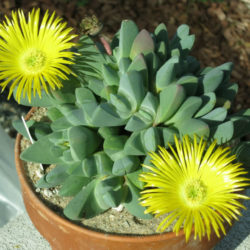Scientific Name
Cheiridopsis brownii Schick & Tisch.
Synonym(s)
Cheiridopsis graessneri, Cheiridopsis hallii, Cheiridopsis insignis, Cheiridopsis pachyphylla, Cheiridopsis schlechteri, Cheiridopsis staminodifera, Cheiridopsis turgida
Scientific Classification
Family: Aizoaceae
Subfamily: Ruschioideae
Tribe: Ruschieae
Genus: Cheiridopsis
Description
Cheiridopsis brownii is a small succulent with opposite pairs of fat, not gaping, mildly keeled leaves on short branches. It forms dense clumps that can reach up to 2 inches (5 cm) in height and 6 inches (15 cm) in diameter. The leaves are pale greyish-green or greenish-tan with tiny darker spots. The leaves are never toothed, fused for nearly half the length, and grow up to 2 inches (5 cm) long. They take on a brown hue when exposed to intense sunlight. Sheaths from old leaves cover up to a third of the leaves.
The solitary, short-stalked flowers appear from the stem tips in fall. Flowers are about (4 cm) in diameter with numerous narrow, yellow petals, white filaments, and yellow anthers. The fruits are flat-topped capsules with ten to twenty locules.
Origin
The native range of Cheiridopsis brownii is from southern Tsau ǁKhaeb National Park, formerly known as Sperrgebiet, in Namibia to Alexander Bay in the Northern Cape province of South Africa. It grows in sandy soil, gravel, or shale on dolomite flats.

Hardiness
USDA hardiness zone 10a to 11b: from 30 °F (−1.1 °C) to 50 °F (+10 °C).
How to Grow and Care
The basics of Mesemb care are very simple, with free-draining soil, plenty of sun and ventilation, and regular light watering in the right season. Yet the difficulties are endless, trying to adapt to the Mesembs' adaptability and follow their growth habits in your particular conditions.
Mesembs require a loam-based compost with extra drainage material such as horticultural grit or perlite. They all like good light conditions and plenty of ventilation.
Some are relatively cold-hardy and can even survive mild winters outside. Most will survive temperatures down to the freezing point. Some Mesembs begin to grow in the autumn as the temperature drops and the days get shorter.
Because different genera within the Mesemb family have different growing conditions, care must be taken with watering. Some genera will benefit from light spray water to prevent shriveling during their dormant period.
See more at How to Grow and Care for Mesembs.
Links
- Back to genus Cheiridopsis
- Succupedia: Browse succulents by Scientific Name, Common Name, Genus, Family, USDA Hardiness Zone, Origin, or cacti by Genus
Photo Gallery
Click on a photo to see a larger version.


